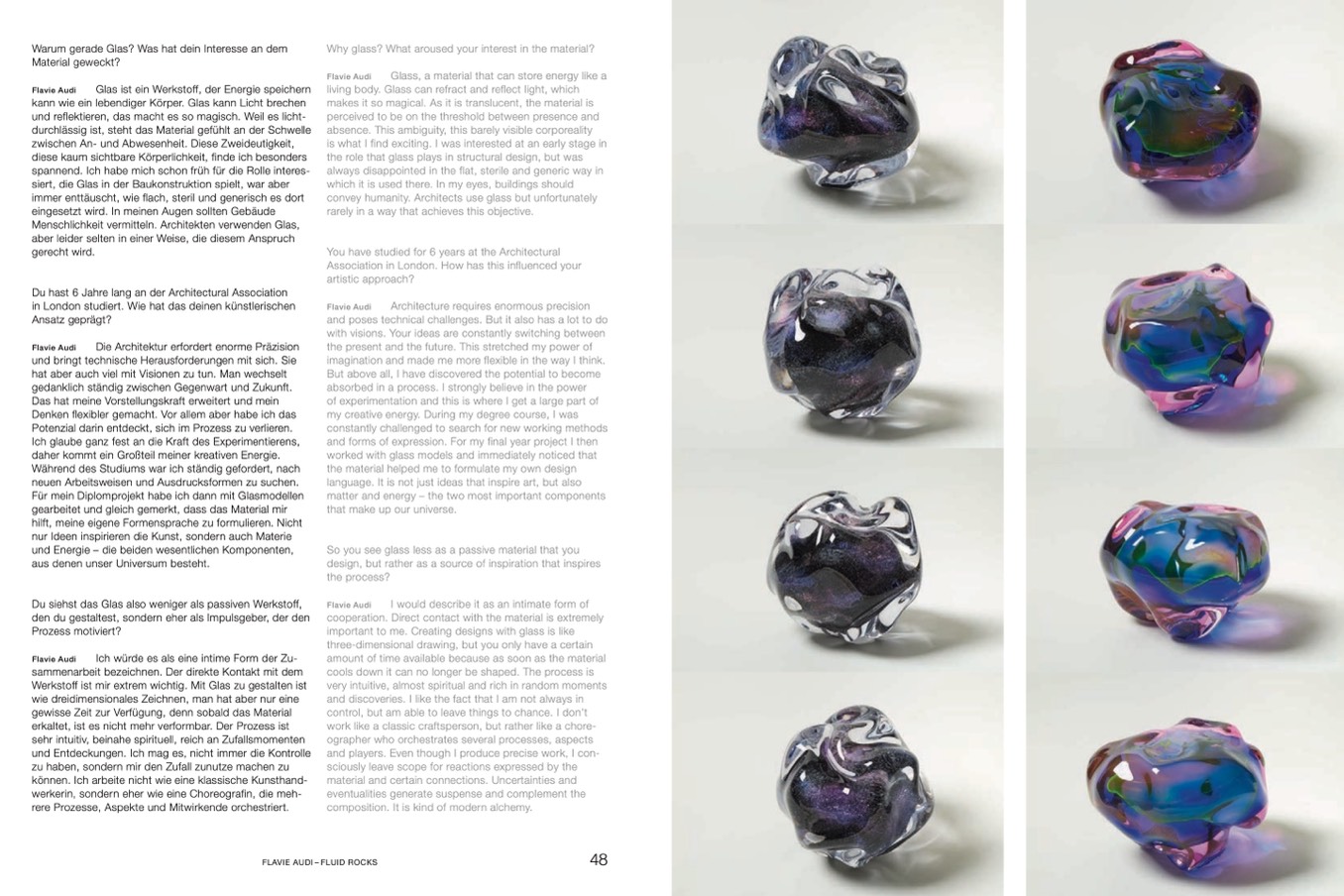
Warum gerade Glas? Was hat dein Interesse an dem
Material geweckt?
Flavie Audi
Glas ist ein Werkstoff, der Energie speichern
kann wie ein lebendiger Körper. Glas kann Licht brechen
und reflektieren, das macht es so magisch. Weil es licht
durchlässig ist, steht das Material gefühlt an der Schwelle
zwischen An und Abwesenheit. Diese Zweideutigkeit,
diese kaum sichtbare Körperlichkeit, finde ich besonders
spannend. Ich habe mich schon früh für die Rolle interes
siert, die Glas in der Baukonstruktion spielt, war aber
immer enttäuscht, wie flach, steril und generisch es dort
eingesetzt wird. In meinen Augen sollten Gebäude
Menschlichkeit vermitteln. Architekten verwenden Glas,
aber leider selten in einer Weise, die diesem Anspruch
gerecht wird.
Du hast 6 Jahre lang an der Architectural Association
in London studiert. Wie hat das deinen künstlerischen
Ansatz geprägt?
Flavie Audi
Die Architektur erfordert enorme Präzision
und bringt technische Herausforderungen mit sich. Sie
hat aber auch viel mit Visionen zu tun. Man wechselt
gedanklich ständig zwischen Gegenwart und Zukunft.
Das hat meine Vorstellungskraft erweitert und mein
Denken flexibler gemacht. Vor allem aber habe ich das
Potenzial darin entdeckt, sich im Prozess zu verlieren.
Ich glaube ganz fest an die Kraft des Experimentierens,
daher kommt ein Großteil meiner kreativen Energie.
Während des Studiums war ich ständig gefordert, nach
neuen Arbeitsweisen und Ausdrucksformen zu suchen.
Für mein Diplomprojekt habe ich dann mit Glasmodellen
gearbeitet und gleich gemerkt, dass das Material mir
hilft, meine eigene Formensprache zu formulieren. Nicht
nur Ideen inspirieren die Kunst, sondern auch Materie
und Energie – die beiden wesentlichen Komponenten,
aus denen unser Universum besteht.
Du siehst das Glas also weniger als passiven Werkstoff,
den du gestaltest, sondern eher als Impulsgeber, der den
Prozess motiviert?
Flavie Audi
Ich würde es als eine intime Form der Zu
sammenarbeit bezeichnen. Der direkte Kontakt mit dem
Werkstoff ist mir extrem wichtig. Mit Glas zu gestalten ist
wie dreidimensionales Zeichnen, man hat aber nur eine
gewisse Zeit zur Verfügung, denn sobald das Material
erkaltet, ist es nicht mehr verformbar. Der Prozess ist
sehr intuitiv, beinahe spirituell, reich an Zufallsmomenten
und Entdeckungen. Ich mag es, nicht immer die Kontrolle
zu haben, sondern mir den Zufall zunutze machen zu
können. Ich arbeite nicht wie eine klassische Kunsthand
werkerin, sondern eher wie eine Choreografin, die meh
rere Prozesse, Aspekte und Mitwirkende orchestriert.
Why glass? What aroused your interest in the material?
Flavie Audi
Glass, a material that can store energy like a
living body. Glass can refract and reflect light, which
makes it so magical. As it is translucent, the material is
perceived to be on the threshold between presence and
absence. This ambiguity, this barely visible corporeality
is what I find exciting. I was interested at an early stage in
the role that glass plays in structural design, but was
always disappointed in the flat, sterile and generic way in
which it is used there. In my eyes, buildings should
convey humanity. Architects use glass but unfortunately
rarely in a way that achieves this objective.
You have studied for 6 years at the Architectural
Association in London. How has this influenced your
artistic approach?
Flavie Audi
Architecture requires enormous precision
and poses technical challenges. But it also has a lot to do
with visions. Your ideas are constantly switching between
the present and the future. This stretched my power of
imagination and made me more flexible in the way I think.
But above all, I have discovered the potential to become
absorbed in a process. I strongly believe in the power
of experimentation and this is where I get a large part of
my creative energy. During my degree course, I was
constantly challenged to search for new working methods
and forms of expression. For my final year project I then
worked with glass models and immediately noticed that
the material helped me to formulate my own design
language. It is not just ideas that inspire art, but also
matter and energy – the two most important components
that make up our universe.
So you see glass less as a passive material that you
design, but rather as a source of inspiration that inspires
the process?
Flavie Audi
I would describe it as an intimate form of
cooperation. Direct contact with the material is extremely
important to me. Creating designs with glass is like
threedimensional drawing, but you only have a certain
amount of time available because as soon as the material
cools down it can no longer be shaped. The process is
very intuitive, almost spiritual and rich in random moments
and discoveries. I like the fact that I am not always in
control, but am able to leave things to chance. I don’t
work like a classic craftsperson, but rather like a chore
ographer who orchestrates several processes, aspects
and players. Even though I produce precise work, I con
sciously leave scope for reactions expressed by the
material and certain connections. Uncertainties and
eventualities generate suspense and complement the
composition. It is kind of modern alchemy.
FLAVIE AUDI – FLUID ROCKS
48

